You’re probably already aware:
Content marketing is one of the most effective ways to increase your traffic, conversions and sales:
- B2B businesses that create blog content see 67% more leads
- Websites with blogs bring in 15x more traffic than websites without blogs.
If done right, content can build your audience, boost your brand and put you on the map.
But there are so many different types of content, how do you know which to focus your efforts on for maximum impact?
Don’t worry. We’ve got your back.
In this guide, I’ll go over the 13 type of content, how to create them, and tips to maximize the effectiveness of each type…
You know, so you don’t waste any of that precious time.
Ready?
Here’s what we’ll go over:
- List Posts
- Ultimate Guides
- Expert Roundup Posts
- Example Roundup Posts
- Rallying Cry Posts
- Inspirational Posts
- Educational Posts
- Lead by Example Posts
- Series Posts
- Tools Posts
- The Getting to Know You Post
- Q&A Posts
- Exclusive Resources and Tools
Alright, let’s get into it – starting, of course, with one of the most effective and widely used type of content:
List Posts
You’ve seen them everywhere…
Like this helpful one from Restart Your Style:

And this from Productivityist:
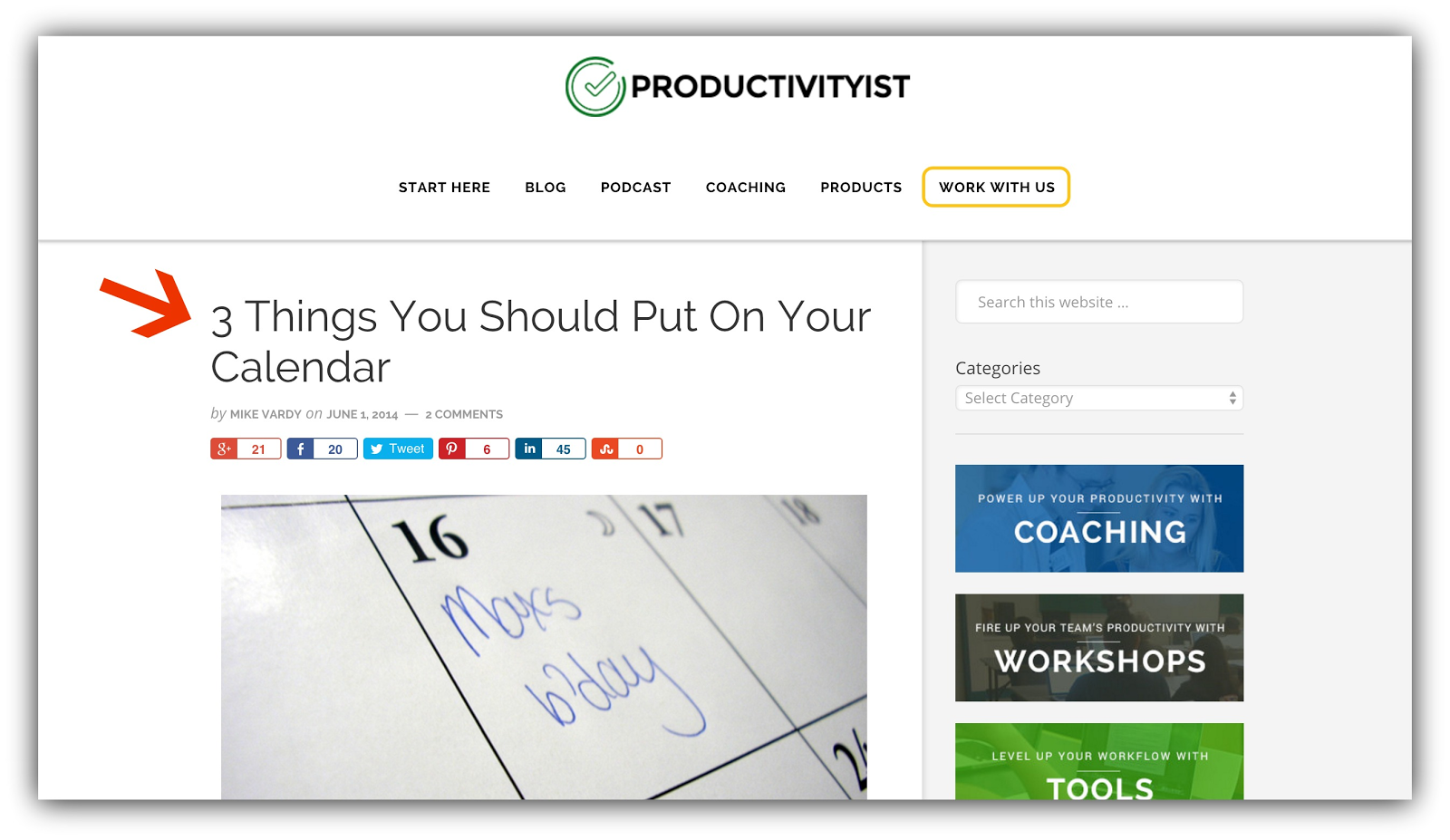
Not to mention the hundreds of examples from BuzzFeed, ViralNova and The Huffington Post.
The much debated list post.
Yeah, I know. Your knee-jerk reaction might be to avoid lists at all costs.
List posts (often called “listicles”) get a terrible rap. They’re considered the bottom feeders of web content, because websites exploit their ability to create them quickly, pumping out useless filler content to try to manipulate SEO.
Don’t be too quick to write off list posts, though.
If you approach list posts in the right way, they can be extremely useful for your audience.
We took a list post approach to one of our recent guides, turning it into an insanely useful, 3,500 word guide to help you create your autoresponder series:
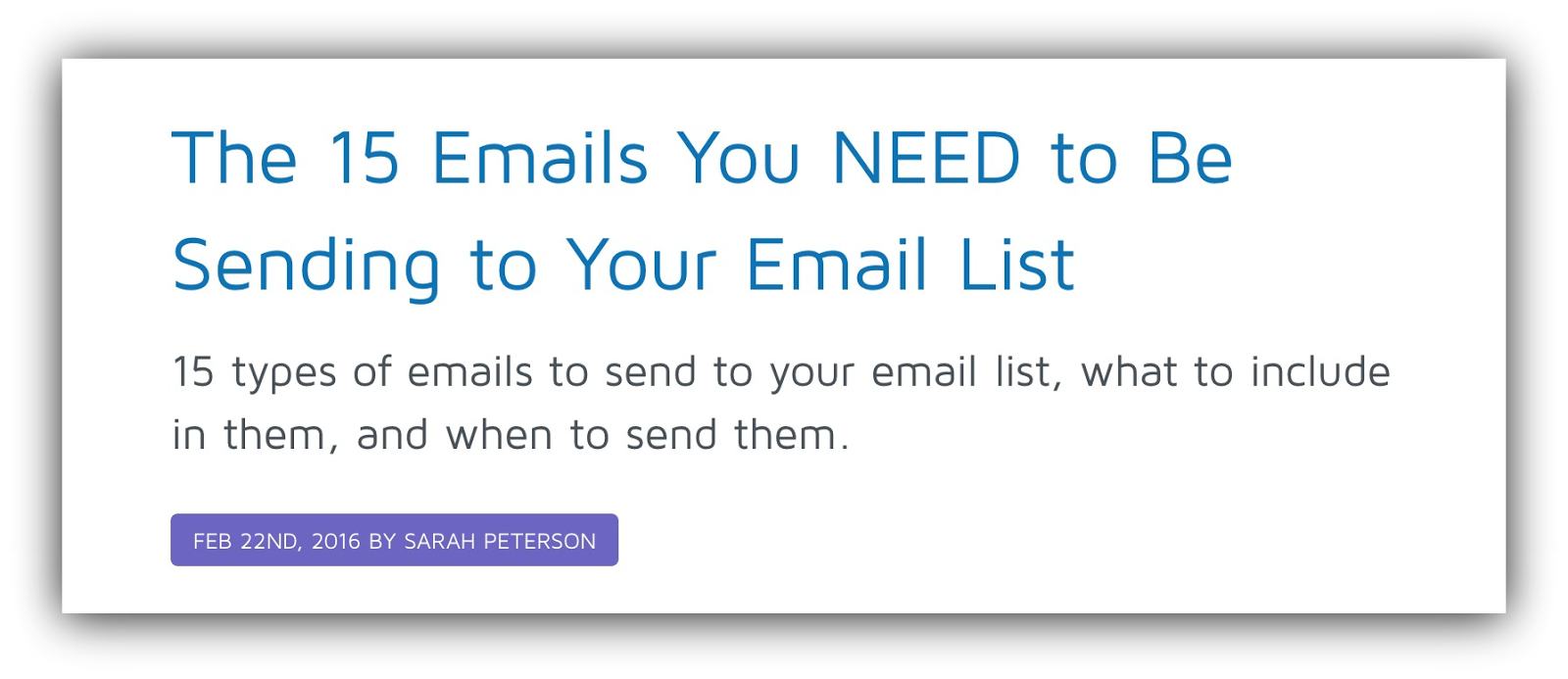
They’re everywhere because they work. People love list posts just as much as they love to hate Kim Kardashian. Our brains love numbers and numbered lists (likely because we like to know what to expect).
Instead of thinking of list posts as filler content, just think of them as a way to organize the extremely useful data you’ll publish. When you’re creating a list post, offer a TON of value.
Instead of just listing things off, go into detail. Give actionable advice. Give away the farm.
Ultimate Guides
Content marketing is all about teaching.
And, as Jason Fried and David Heinemeier Hansson say on the excellent book Rework, teaching is one of the best ways to develop a relationship with your audience and provide immense value.
That’s where the ultimate guide comes in.
Ultimate guides are the definitive resource for a specific topic. Even our list posts on Sumo are ultimate guides. Ultimate guides dig deep into a topic, giving it all away, and leaving nothing out.
When we write an ultimate guide for the Sumo blog, we include absolutely everything about the topic. They end up being thousands of words (if not 10,000+) and aim to be like a miniature course…
Like our Sumo-Sized Guide on driving traffic from Facebook:
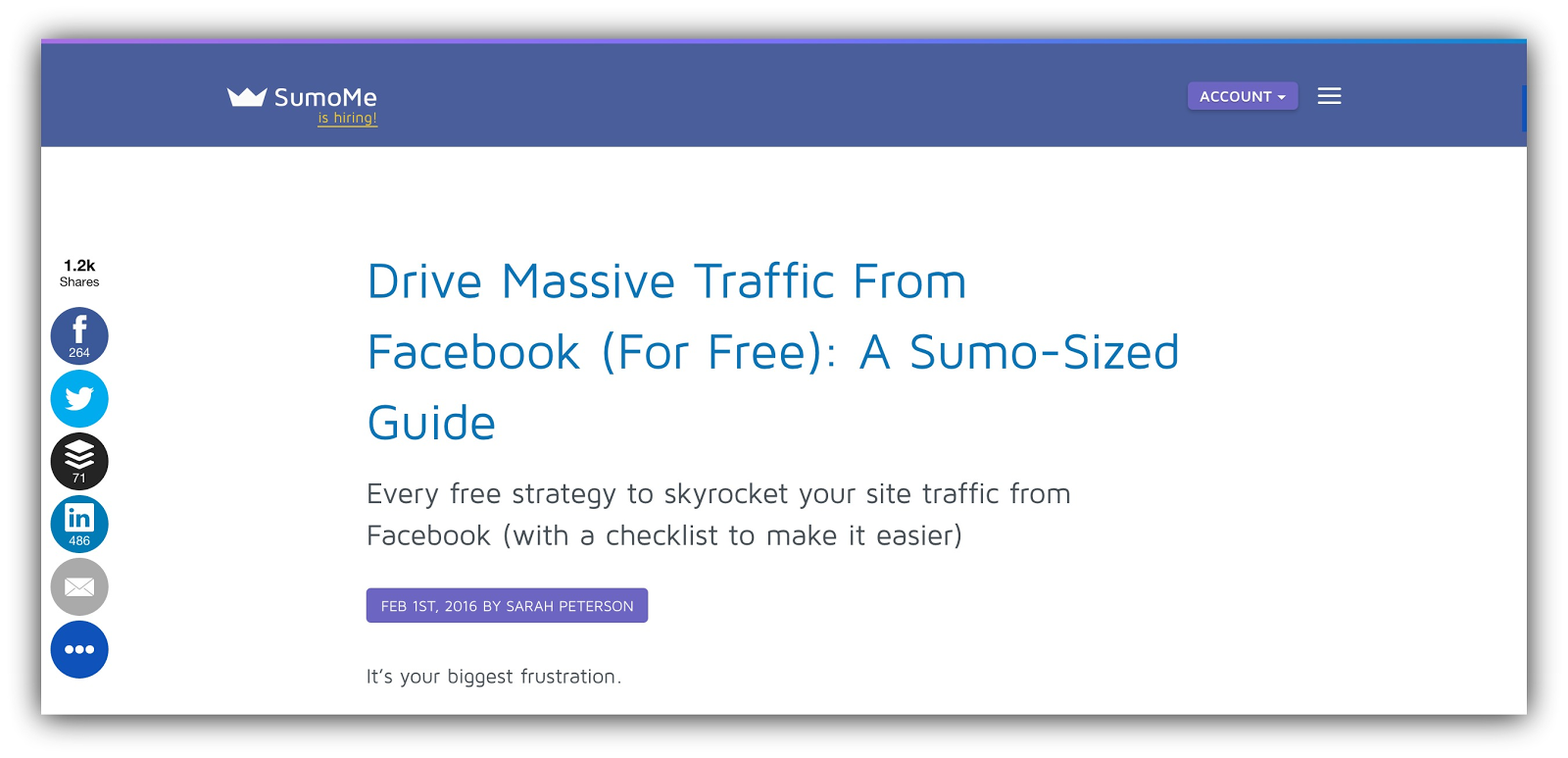
You can create ultimate guides for beginners or more advanced users on a topic. Check out how Nerd Fitness catered to their beginner readers with this meaty guide to the paleo diet (see what I did there?):

Ultimate guides can take a substantial time commitment to create, but when done right, the benefits of creating the definitive resource on something are mind-blowing.
Ultimate guides most often end up becoming evergreen cornerstone content that work hard for you far after you’ve created them.
These definitive resources can put you on the map, rake in the search engine traffic, convert like crazy and bring more customers and clients than you’ll know what to do with.
Expert Roundup Posts
Have you written a piece of content that brought in more than 20,000 views, 1,500 shares and 80 comments?
If not, that may just be because you haven’t created an expert roundup post.
In our guide to creating expert roundup posts, Tor Refsland describes how to write an epic expert roundup post, where you collect several influencer or expert’s opinions on something – and then round them up into a guide or opinion piece.
You can see how this is done on SuccessisWhat with Peter’s roundup for beating procrastination:
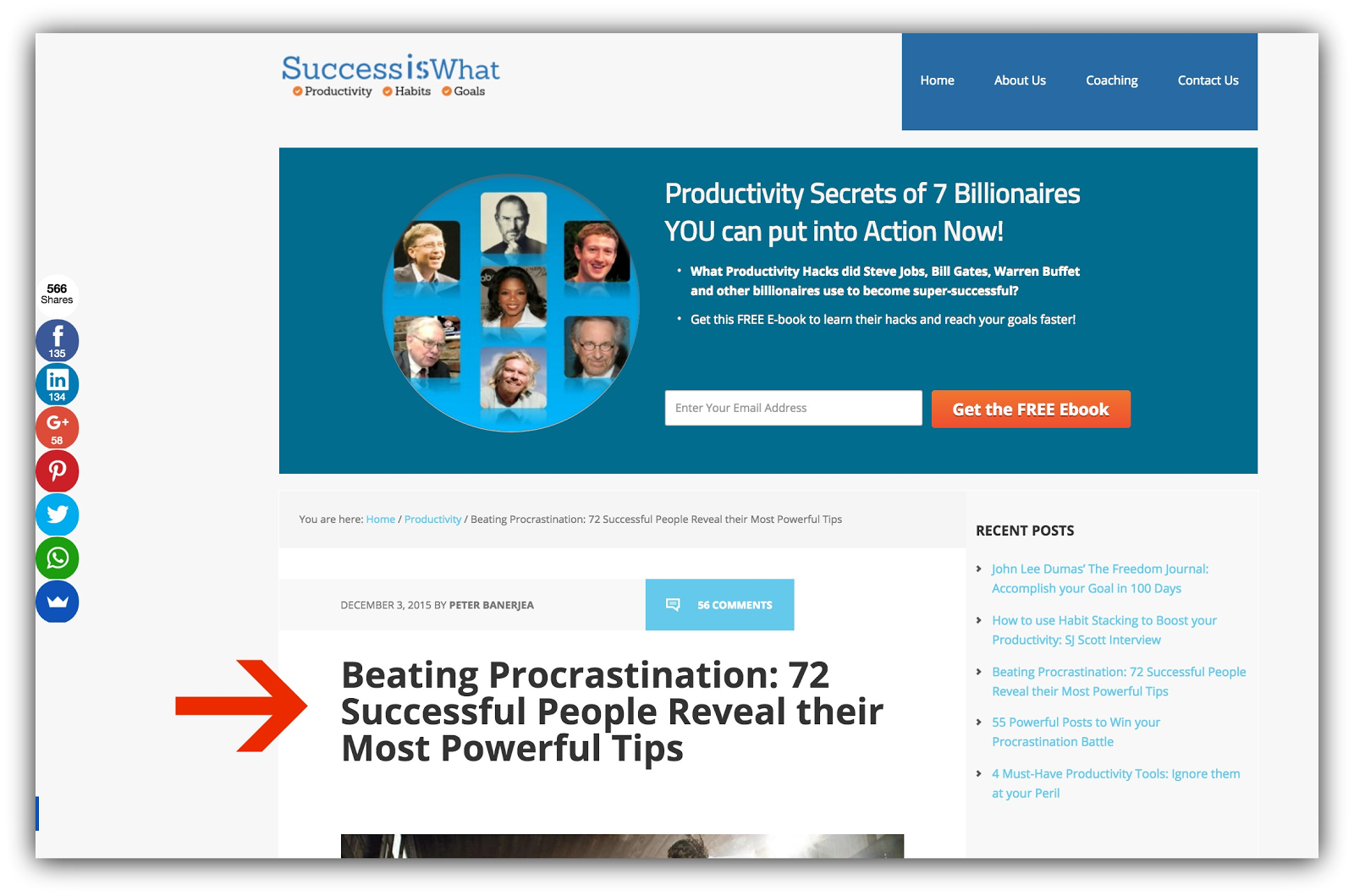
Take a look at that sexy list post headline, too.
There are a couple of reasons this works so well for traffic, shares and conversions:
- The people you featured tend to share with their audience. Influencers and experts tend to have larger audiences than you do
- This triggers the false fame effect, where the “fame” of the influencer rubs off on you. This provides a nice boost of social proof, which increases conversions by 30% or more.
One thing with expert roundup posts that you should be careful of is that they can take a long time – not because you’re writing a lot, but because you have to chase people down.
Sending out dozens of emails with your request, compiling and curating the answers, making sure they’re formatted nicely – it can all be a lot of work.
If you’d rather not chase people down, try out the next type of content…
Example Roundup Posts
So let’s say you were feeling a bit lazy and didn’t want to have to chase down experts and influencers for quotes for your expert roundup post…
But you still wanted to cash in on the awesome benefits they provide.
How convenient.
Well luckily, you can do this…
Through an example roundup post – where you use experts and influencers as an example to illustrate a point.
This differs from an expert roundup post because you aren’t actually going out and collecting responses – you’re just using the influencer as an example.
I did this for my article on the Buffer blog:
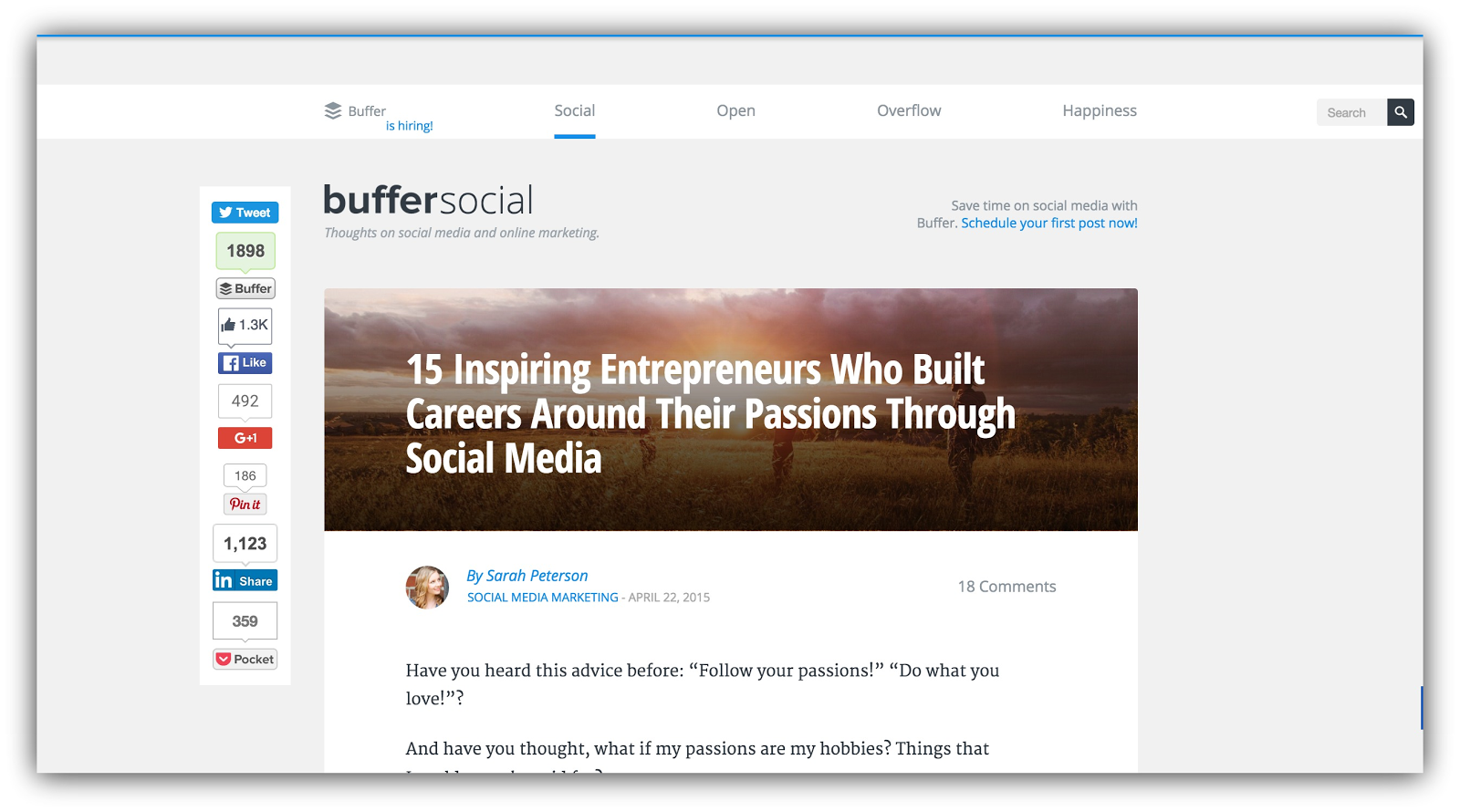
Which, perhaps not unsurprisingly ended up being one of the top two most popular articles on Buffer of 2015.
After all, some of the influencers I mentioned in the article shared it with their massive audiences, which undoubtedly was responsible for a portion of the nearly 15,000 social shares.
With example roundup posts, the experts you’re featuring may not be aware you’ve mentioned them, which is why you should reach out to them and let them know.
Example roundup posts can also be extremely useful for your audience, because examples of people who have done something in the past tend to help us learn better.
Inspirational Posts
Almost all content does one of a few different things:
- Educates
- Entertains
- Inspires
Inspirational content is one of the most viral forms of content, because it tends to elicit emotion.
Say it with me, class:
“The most popular content is content that elicits high arousal emotion”.
In case you’re new here, I like to remind you of this every second guide or so.
Most audiences could use a little inspiration or motivation, so why not take advantage of this fact and create content to serve this purpose like the team at Fizzle has done?:

Rather than just posting little messages of inspiration (which may be better suited for social media), up the ante on inspirational posts by giving actionable steps and information the audience can use when they’re all amped up from your motivational message.
Rallying Cry Posts
There are regular businesses and blogs…
And then there are the ones that build strong, loyal communities around them. And those are the ones that spread like crazy.
One great way to build a sense of community around your content is to create a “rallying cry” post – a piece of content meant to unite your audience around a specific idea, topic or theme.
Usually, this is done around a principal of your brand. Do you have a strong opinion or position on something in your brand that you can “rally” around in your content?
These posts are usually motivational to the right audience, and repel the wrong type of people. In case you aren’t aware, this is where marketing magic is made.
Get your audience worked up about something in your topic, like Chris Guillebeau has done in his article How to Be Unremarkably Average:

These work so well to drive traffic (and even conversions) because they tend to be a bit controversial, and controversial topics tend to drive high arousal emotion which drive shares.
Educational Posts
Educating your audience by giving as much information away as possible (yep, for free) builds trust with your readers, and establishes your expertise.
While almost all of the types of content in this guide aim to educate (or inspire, or entertain) in some way, this type of post explains a specific problem, concept or idea to the audience.
The educational post establishes credibility and expertise and can be powerful to help solve a problem or answer a question, like Anthony from Magnetic Memory Method has done to educate his audience about how sleep affects memory:

If your website or business is one that can collect data, you can use these numbers in an educational post as well. We did this when we reported on how well your email opt-ins should be converting.
Jay Abraham said that if you can define a problem better than your customer, they assume you have the solution. There’s no better way to define a problem then through an educational post.
Lead by Example Posts
Chances are, you’re creating content around your topic because you know a thing or two about it – from experience.
That’s why your audience follows you, right? Most of us have something we can demonstrate for our audiences.
That’s where this post comes in. The lead by example post shows your audience how to do something that you’ve done, wrapping your personal story into the instruction.
Taylor from The Freedom From Money has done this to teach her audience how to save 50% of their income like she does:
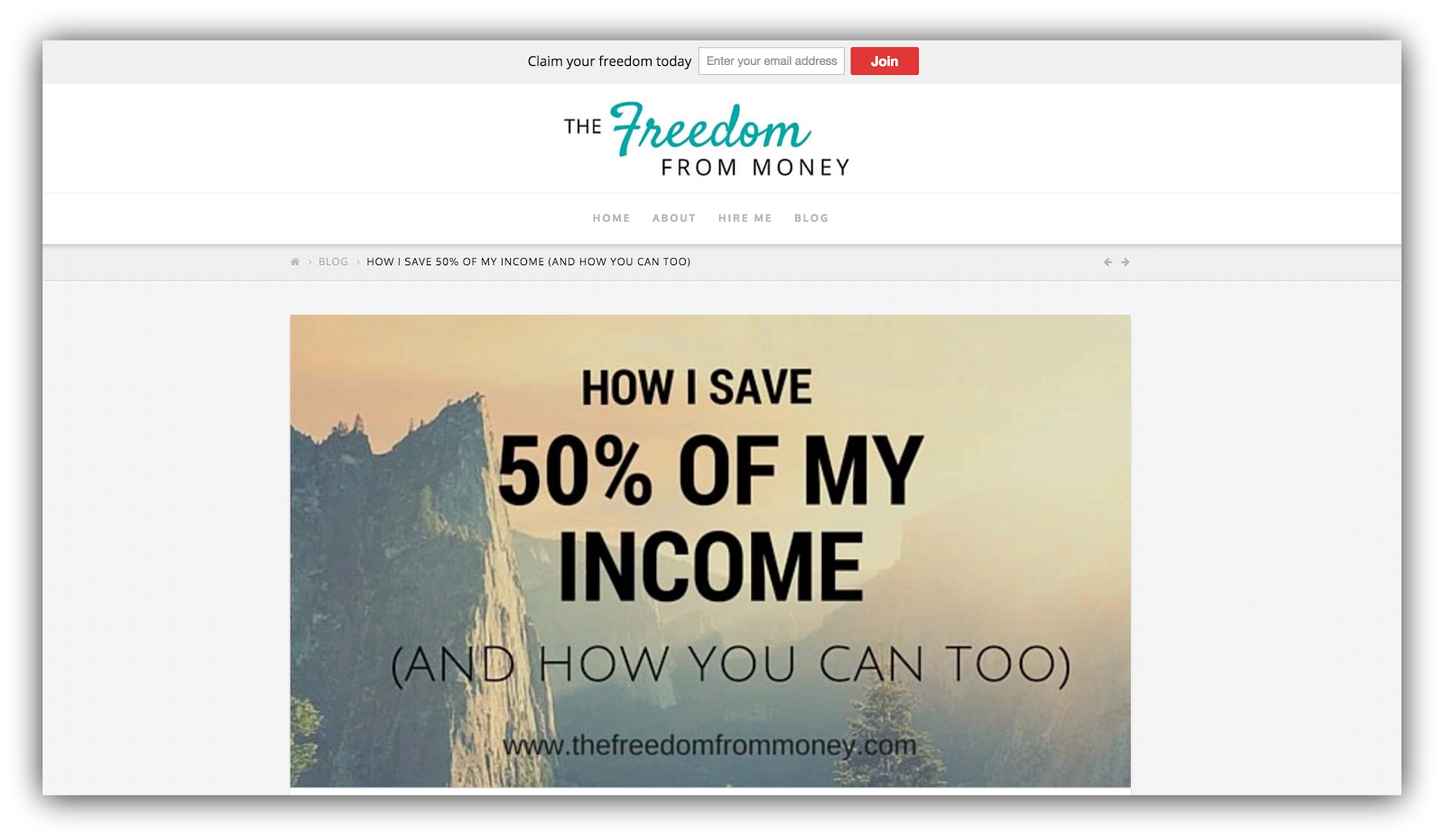
This post not only helps your audience achieve something, it also establishes expertise and builds a relationship with them. After all, they’re reading about your personal story. It’s an excellent opportunity to share more of yourself with them.
We have also done this in my guide to writing enormously popular content in a less personal way.
This type of post combines examples (from yourself) with actionable strategies and steps to achieve something, allowing you to both educate and bond with the audience. It’s a win/win.
Series Posts
Have you ever started to create a piece of content that quickly grew legs of it’s own?
All of a sudden that straight forward guide you were writing ended up becoming a behemoth – and far too much for regular blogs not like Sumo to publish in one shot.
These types of situations are perfect for the series posts.
Break up the information into smaller, natural chunks and drop it out to your audience, and then tease the next post in the series to generate buzz and anticipation and at the end, make sure they’re all interlinked for easy reference.
You can do this around something you’re teaching your audience, different takes on the same topic from different experts within your company (like we did with our 0 to 10K series – Nat’s here, and Sarah’s here) or even a meaty topic that is complex in nature.
Tools Posts
In our guide to the types of emails to send to your list, I told you that people love tools.
Your audience does too. It’s because we love anything that can help us achieve something in less time (of course!).
Almost every industry has tools or resources that can be used to make something even a little bit easier. We did this with our guide to all the tools you can use to drive traffic from Facebook:
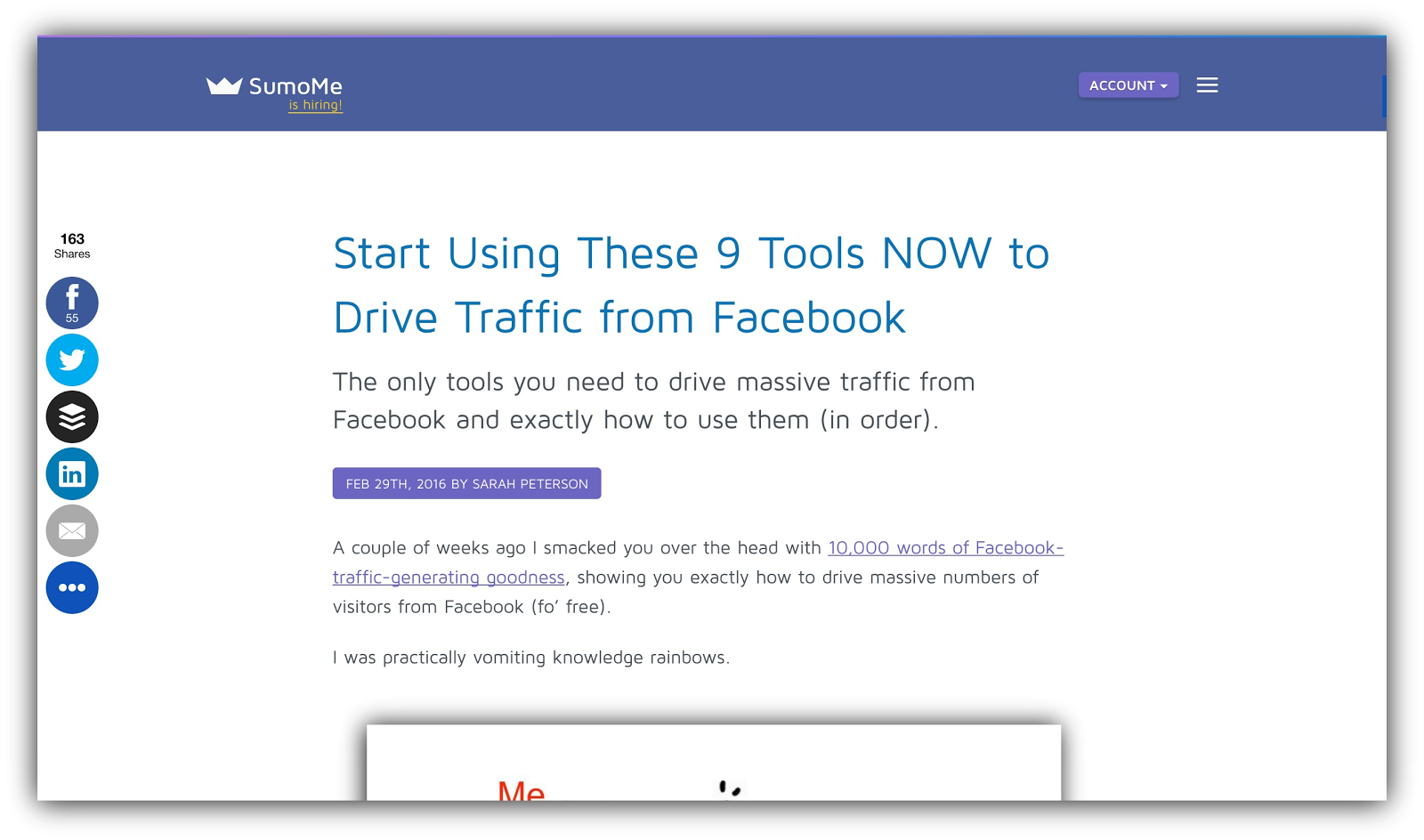
Brainstorm all the tools that your audience can use, and go over how they can use them. Don't be afraid to give examples of how you’ve used the tools and how they’ve worked for you.
The Getting to Know You Post
The best content marketers not only educate, entertain and inspire their audiences…
But they also bond with them.
Crazy, right?
The thing is, we like to buy things from people we know, like, and trust.
And we can’t know, like, or trust somebody who we know nothing about. Your audience wants to know the person behind the content. That’s why your About page is likely one of the most frequently visited pages on your website.
It’s the personal details that your audience remembers – sometimes even more than what you’re teaching them. This is also why personal brands work so well…
And why this post is so valuable.
The getting to know you post builds a bond between the reader and yourself, because you’re offering a more intimate and personal look into you – the person behind the content.
These posts can feel a bit self-indulgent, but you may be surprised as to how much your audience loves them.
These are often done around a personal event, like a birthday, like Chloe from One Hour Behind has done:

Q&A Posts
As you continue to create content and build your email list, you’ll inevitably get some questions.
And you’ll start to notice patterns in the questions you get. Sometimes, the answers to those questions warrant their own entire educational post, but sometimes the answers are quick or simple.
And the latter is the perfect type of question for the Q&A post.
As you notice these questions coming up, occasionally doing a post with answers to frequently asked questions can be fun, useful and can also take the pressure off of you from having to think up a topic for your content.
Noah celebrated his birthday with a Q&A post on OkDork.com:
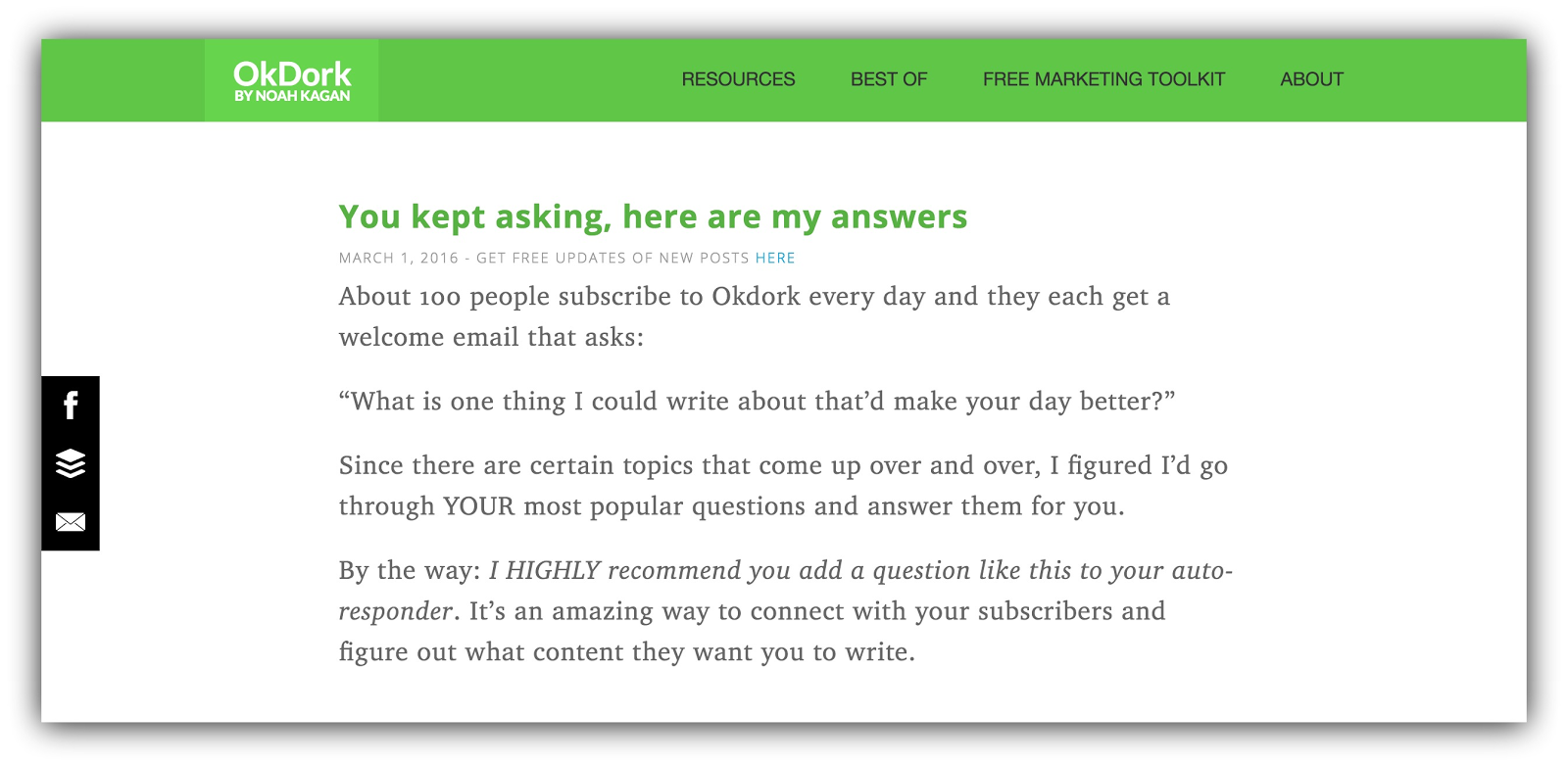
And on podcasts and videos, the Q&A post consistently becomes one of the most popular pieces of content among existing audience members.
Exclusive Resources and Tools
It’s always nice to spoil your audience a bit.
After all, they’re your fans. They’re the ones who share your content, interact with you, and ultimately end up buying your products and services.
That’s why giving them exclusive (and free!) access to tools and resources you’ve created can win friends (and influence people!)
We’ve done this with our kickass headline generator:
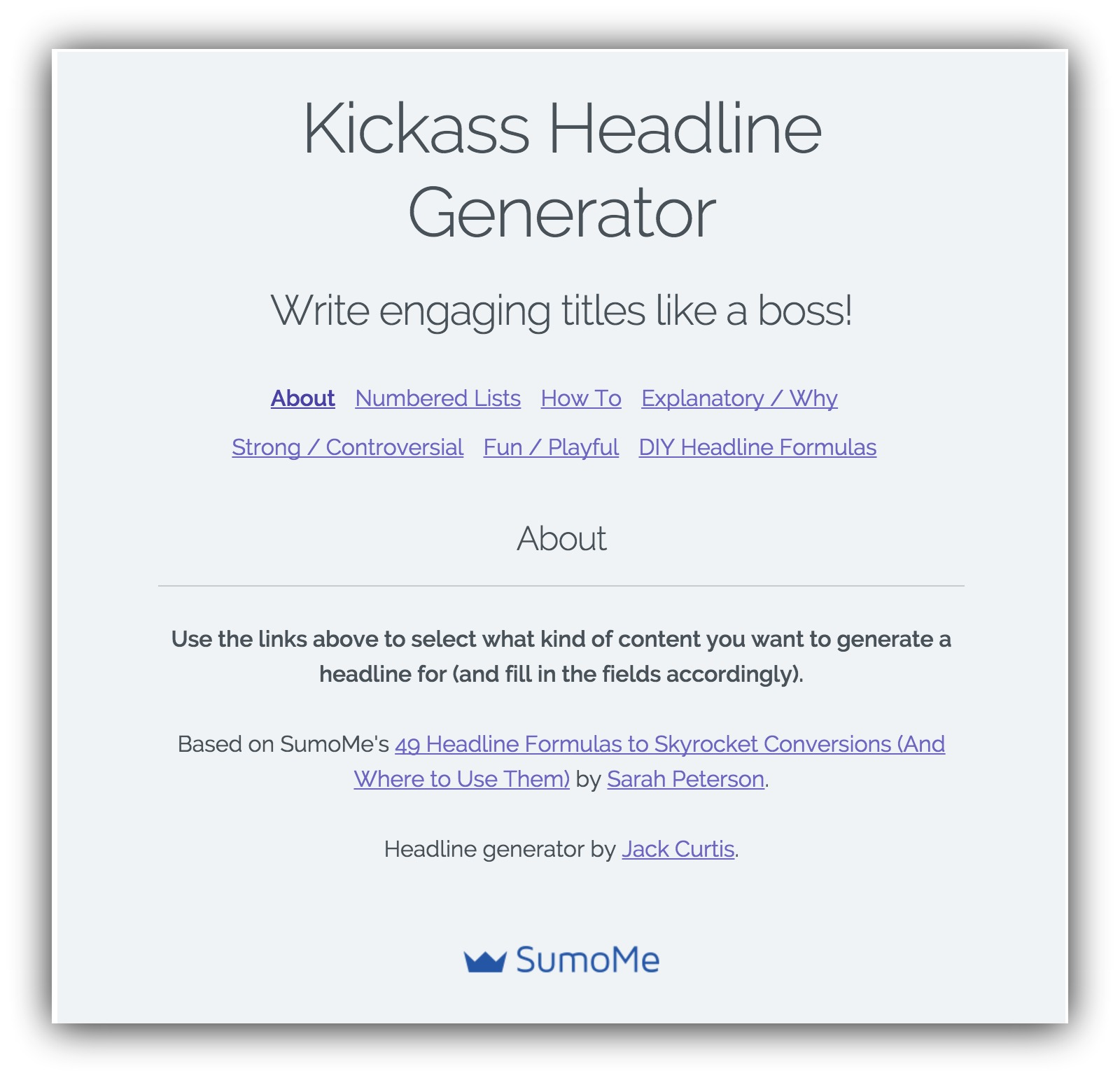
Go get some of this headliney goodness here.
And while not all businesses can offer their audiences tools like this, some can. Another example is Buffer, which released Pablo:

Think of this type of content like an opt-in offer, except without actually requiring the person to opt in to your email list. They get a free bonus just for being part of your audience.
Stop Letting Traffic and Conversions Slip Through Your Fingers
If you’re not consistently creating high value content for your audience, I have bad news for you:
You’re letting traffic, leads, and conversions slip through your fingers like the world’s worst sieve.
Now that you have 13 types of content to publish, you have no reason to miss out on the benefits of content marketing.
So where should you start?
- Step 1: Choose one type of content you think will resonate with your readers. I suggest you start with an ultimate guide, to create cornerstone content that will pay you dividends in the future.
- Step 2: Create a publishing schedule. How often will you publish content on your website? Consistency is key here.
- Step 3: Create, create, create! Test out different types of content and see what your audience responds to. And if you’re lost on how to create the content, check out our guide to reverse engineering enormously popular content.
And do me a favor? If you found this guide useful, send it to one person who could benefit from content marketing and wants more exposure, sales, and leads.










Add A Comment
VIEW THE COMMENTS